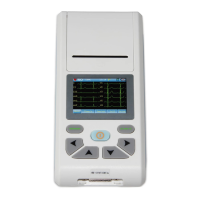44 Old inferolateral MI
45 ST depression, mild anteroseptal myocardial ischemia
46 ST depression, mild anterior myocardial ischemia
ST depression, mild extensive anterior myocardial ischemia
48 ST depression, mild apical myocardial ischemia
49 ST depression, mild anterolateral myocardial ischemia
ST depression, mild high lateral myocardial ischemia
51 ST depression, mild inferior myocardial ischemia
52 ST depression, mild inferolateral myocardial ischemia
ST depression, anteroseptal myocardial ischemia
54 ST depression, anterior myocardial ischemia
55 ST depression, extensive anterior myocardial ischemia
ST depression, apical myocardial ischemia
57 ST depression, anterolateral myocardial ischemia
58 ST depression, high lateral myocardial ischemia
ST depression, inferior myocardial ischemia
60 ST depression, inferolateral myocardial ischemia
2.3 Intended use
The intended use of the Automated Measurement&Interpretation function is shown as
below:
Application
To detect the abnormal of heart of human body, examination items refer to
Population Teenagers and adults, age range: 12-87
Application
hospitals
Accuracy
The accuracy of this function is reflected by the balance performance of
sensitivity and specificity.
Others
This function does not generate any alarm when using, so it should be
operated by professional or trained personal.
3. Algorithm description
This section describes the algorithm, formulas and judgment conditions for interpretation
items related to functions of ECG automated measurement and automated interpretation.
The 12-lead sync ECG waveform passes through the filter (AC, EMG, DFT (if has, and
open)) into the module of automated measurement and automated interpretation.
The module of automated measurement and automated interpretation mainly includes
process of find the cardiac impulse location, find the beginning/end for each wave, amplitude
calculation, parameters calculation, and interpretations judgment based on known parameters.

